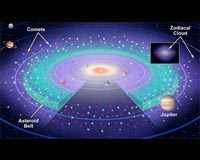 |
Tallahassee FL (SPX) Apr 29, 2010 The first-ever discovery of ice and organic molecules on an asteroid may hold clues to the origins of Earth's oceans and life 4 billion years ago. University of Central Florida researchers detected a thin layer of water ice and organic molecules on the surface of 24 Themis, the largest in a family of asteroids orbiting between Mars and Jupiter. Their unexpected findings will be published in Nature, which will featuretwo complementary articles by the UCF-led team and by another team of planetary scientists. "What we've found suggests that an asteroid like this one may have hit Earth and brought our planet its water," said UCF Physics Professor HumbertoCampins, the study's lead author. Some theories suggest asteroids brought water to Earth after the planet formed dry. Scientists say the salts and water that have been found in some meteorites support this view. Using NASA's Infrared Telescope Facility in Hawaii, Campins and his team of researchers measured the intensity of the reflected sunlight as 24 Themis rotated. Differences in intensity at different wavelengths helped researchers determine the makeup of the asteroid's surface. Researchers were surprised to find ice and carbon-based compounds evenly distributed on 24 Themis. More specifically, the discovery of ice is unexpected because surface ice should be short lived on asteroids, which are expected to be too warm for ice to survive for long. The distance between this asteroid and the sun is about three times greater than between Earth and the sun. Researchers will continue testing various hypotheses to explain the presence of ice. Perhaps most promising is the possibility that 24 Themis might have preserved the ice in its subsoil, just below the surface, as a kind of "living fossil" or remnant of an early solar system that was generally considered to have disappeared long ago.
Share This Article With Planet Earth
Related Links University of Central Florida Asteroid and Comet Mission News, Science and Technology
 Source Of Zodiac Glow Identified
Source Of Zodiac Glow IdentifiedBoulder CO (SPX) Apr 16, 2010 The eerie glow that straddles the night time zodiac in the eastern sky is no longer a mystery. First explained by Joshua Childrey in 1661 as sunlight scattered in our direction by dust particles in the solar system, the source of that dust was long debated. In a paper to appear in the April 20 issue of The Astrophysical Journal, David Nesvorny and Peter Jenniskens put the stake in asteroid ... read more |
|
| The content herein, unless otherwise known to be public domain, are Copyright 1995-2010 - SpaceDaily. AFP and UPI Wire Stories are copyright Agence France-Presse and United Press International. ESA Portal Reports are copyright European Space Agency. All NASA sourced material is public domain. Additional copyrights may apply in whole or part to other bona fide parties. Advertising does not imply endorsement,agreement or approval of any opinions, statements or information provided by SpaceDaily on any Web page published or hosted by SpaceDaily. Privacy Statement |